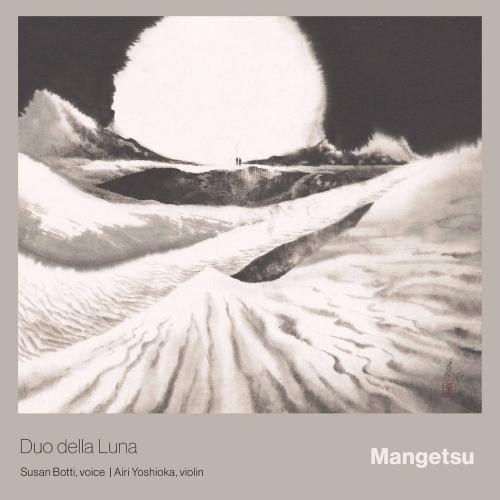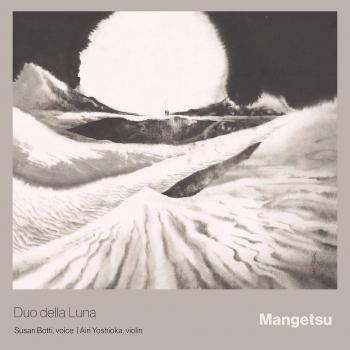
Mangetsu Duo della Luna
Album Info
Album Veröffentlichung:
2021
HRA-Veröffentlichung:
09.07.2021
Label: New Focus Recordings
Genre: Classical
Subgenre: Vocal
Interpret: Duo della Luna
Komponist: Susan Botti (1962), Béla Bartók (1881-1945), Kaija Saariaho (1952)
Das Album enthält Albumcover Booklet (PDF)
- Susan Botti (b. 1962): Mangetsu:
- 1 Botti: Mangetsu: No. 1, Mangetsu 01:27
- 2 Botti: Mangetsu: No. 2, From Darkness 02:41
- 3 Botti: Mangetsu: No. 3, Mangetsu 00:53
- 4 Botti: Mangetsu: No. 4,The Stolen Child 04:39
- 5 Botti: Mangetsu: No. 5, You Told Me 03:02
- 6 Botti: Mangetsu: No. 6, Mangetsu 01:44
- Béla Bartók (1881 - 1945): 44 Duos for 2 Violins, Sz. 98 (Arr. S. Botti for Voice & Violin):
- 7 Bartók: 44 Duos for 2 Violins, Sz. 98 (Arr. S. Botti for Voice & Violin): No. 41, Scherzo 01:05
- 8 Bartók: 44 Duos for 2 Violins, Sz. 98 (Arr. S. Botti for Voice & Violin): No. 28, Sorrow 02:36
- 9 Bartók: 44 Duos for 2 Violins, Sz. 98 (Arr. S. Botti for Voice & Violin): No. 39, Serbian Dance 00:56
- 10 Bartók: 44 Duos for 2 Violins, Sz. 98 (Arr. S. Botti for Voice & Violin): No. 43, Pizzicato 01:05
- 11 Bartók: 44 Duos for 2 Violins, Sz. 98 (Arr. S. Botti for Voice & Violin): No. 42, Arabian Dance 01:27
- Kaija Saariaho (b. 1952):
- 12 Saariaho: Changing Light 05:22
- Traditional:
- 13 Wayfaring Stranger (Arr. S. Botti for Voice & Violin) 05:09
- Linda Dusman (b. 1956):
- 14 Dusman: Triptych of Gossips 12:56
- Traditional:
- 15 Two Italian Folk Songs (Arr. S. Botti for Voice & Violin): No. 1, Guarda che bel serèn 05:22
- 16 Two Italian Folk Songs (Arr. S. Botti for Voice & Violin): No. 2, El me murus el stà de là del Sère 05:31
Info zu Mangetsu
The voice and violin duo Duo della Luna (Susan Botti and Airi Yoshioka, respectively) brings a remarkable versatility and integrated ensemble approach to a rarefied instrumental combination. Both musicians take advantage of their impressive range to broaden the scope of expressive possibilities within this duo formation. On Mangetsu, that range is in full bloom, from Botti’s fluid text delivery in different languages and vocal styles to both performers’ virtuosic navigation of extended techniques and gymnastic passagework. Throughout, the duo is engaged in a intertwined dialogue between the two players, always balanced elegantly, with each fulfilling an equal and essential role in the musical texture. Their sensitive performances are captured in a sensual recording by Grammy award winning engineer and recording industry luminary Todd Whitelock.
Susan Botti’s Mangetsu sets three texts that explore the mystery of the moon by Izumi Shikibu, William Butler Yeats, and Antoine de St.-Exupéry. Connecting these movements are mellifluous, wordless songs (“mangetsu”). The first opens in a delicate halo of sound, as if from afar, and the violin gently follows the contour of the searching vocal line as if performing a ritual dance. A Bartók pizzicato, quick tremolando, and sighing gesture in the violin signals the opening of “From Darkness,” a nocturnal setting sprinkled throughout with lithe vocal melismas. The short third movement is wordless again, replacing the imitative texture of the opening movement with a two voiced texture that suggests harmonic motion. “The Stolen Child” begins with the work’s most vigorous music, opening with a virtuosic violin passage of arpeggios and double stops. A playful section grounded by repeated pizzicati in the violin follows, as the text evolves from a youthful moonlight excursion to unsettling mystery. “You told me” begins rhapsodically, again with violin alone, before the soprano line joins with plaintive, lyrical lines, and the ominous repeated notes from the previous movement return to end the song. The final “mangetsu” is expansive, as Yoshioka’s double stops frame Botti’s poignant phrasing, imbued with powerful expressive meaning despite the absence of text.
For her arrangement of selections from Béla Bartók’s famous set of 44 Duos for Two Violins, Botti alternates between referencing the folk texts from the songs from which Bartók borrowed material and wordless texts, drawing a powerful connection to the rich traditional source. For “Serbian Dance” and “Arabian Dance,” Botti adopts a multi-syllabic sonic palette, character variations, and subtle ornaments to further enliven the original instrumental lines.
Kaija Saariaho’s Changing Light revels in contrasts in dialogue with one another. The text “light and darkness” and “night and day” is sung on one static pitch while the violin plays arpeggiated figures that float through registers. When the text switches to “we marvel at the mystery of the stars,” the vocal part leaps into the high register outlining several intervals while the violin remains stable on a trill. This balancing out of complementary energies unfolds throughout the piece. The line, “as you renew time,” finishes off the work, sung several times, first solo, and then with a series of shimmering double stop trills in the violin.
Botti’s arrangement of “Wayfaring Stranger” takes on the hue of the blues, albeit through a cloudy prism. The violin part hints at characteristic blues fragments, circling around the more straightforward vocal line with improvisatory freedom, occasionally landing on surprising momentary pitch confluences. The final line, “I am just going over home,” is nonetheless unresolved, destabilized by a seesawing figure in the violin that subverts harmonic closure.
Linda Dusman’s Triptych of Gossips sets poetry by Serena Hilsinger of the same name that engages with groups of threes through a proto-feminist lens. “Incantation” opens with airy violin harmonics before the soprano enters with a series of vocal effects over a brittle arpeggio. The texture is fragmentary, cutting between surprising sounds on a dime and building a sonic vocabulary. Hinsliger’s text enters with a flowing line in the violin, also organized primarily in a triple meter. In “Invocation,” Botti’s delivery turns to colorful sprechstimme, as unpredictable punctuations of scratch tones and over-pressure figures in the violin keep the material off-balance. The final phrases are heard in rhythmic unison, the violin and voice tracking each other in maudlin lockstep. The last section, “Convocation,” is the work’s most conventional setting, with flowing, impetuous violin passages. At the work’s climax, the soprano’s forceful lines lead up to a high arrival over searing open string fifths in the violin.
The album closes with two Italian songs from Northern Italy arranged by Botti. In both, the connection to the original tradition is elegantly preserved with stylistic ornamentation in the vocal performance while the violin part embellishes the melody and creates a multi-dimensional conversation between source material and a contemporary concert context. The final song is playfully joyful, capturing the lightheartedness of simple love. The two songs are a fitting close for an album that prizes balancing diverse text sources, aesthetic orientations, and creative ways of approaching the duo instrumentation, all performed with symbiotic grace by Duo della Luna. – Dan Lippel
Susan Botti, soprano
Airi Yoshioka, violin
Duo della Luna
As solo artists, Susan and Airi have devoted their musical careers to new music. After performing together in various chamber settings, Airi commissioned Susan to write a work for just voice and violin, resulting in Botti’s Mangetsu. Realizing that there was a special spark when the music was stripped down to just their two voices intertwined, they formed Duo della Luna to explore this further. The duo has performed in the US, Canada and Italy. Given the unusual vocal/instrumental combination, it was natural that their individual devotion to contemporary works would continue as a duo. Their repertoire celebrates the natural world, myth, story-telling, and folk songs... for their universal, timeless messages.
Susan Botti
Botti's eclectic background and experiences are reflected in her music. Theater and the visual arts play a formative role in the aesthetic of her work. Her musical explorations incorporate traditional, improvisational and non-classical composition and singing styles.
Botti is the recipient of numerous grants, awards, and commissions. In many cases, she is the vocal soloist as well as composer of her works. Collaboration is of special interest – often, her projects evolve from artistic partnerships (including musicians from the NY Philharmonic and The Orpheus Chamber Orchestra; soloists such as singer Lucy Shelton; the poet Linda Gregerson; and theater designer, Leslie Taylor).
Duo della Luna is Botti’s recently formed vocal/violin duo with Airi Yoshioka, specializing in the performance of intimate contemporary music and folk song-inspired arrangements and compositions. Advocating education and outreach, the duo is committed to performing in unusual and underserved venues.
In development is a “theatrical motet”, River Spirits, for three voices and an ensemble of contemporary plus early music instruments – a futuristic abstract fable drawing on Italian “grammelot” and wide-ranging vocal techniques. As with most of her work, the piece strives to tap into the pulse of the human experience.
In addition to performing her own vocal works, Botti specializes in the performance of contemporary music of diverse styles. She has worked directly with composers such as Sofia Gubaidulina, Matthias Pintscher, Paul Chihara, Toshio Hosokawa, Linda Dusman, Eliot Britton, Rahilia Hasanova, Lois V. Vierk, and Wes York. For over a decade, composer/conductor Tan Dun created several major works highlighting her vocal and theatrical talents, including the role of "Water" in his internationally renowned opera, Marco Polo, the vocal solo in his multimedia work for soprano and orchestra, Orchestral Theatre III: Red Forecast, and the vocal solo for the theme to his soundtrack for The Banquet.
Booklet für Mangetsu







